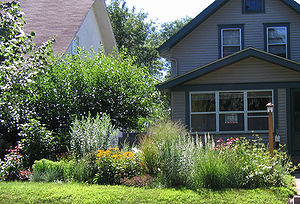
Difference between revisions of "Category:Level 2 - Management/Green infrastructure"
m |
m |
||
| Line 1: | Line 1: | ||
[[File:Native landscaping.jpg|thumb|300px|alt=photo of a rain garden planted with native vegetation|<font size=3>Example of a rain garden planted with native vegetation. In addition to providing stormwater treatment, bioretention practices can provide other benefits such as habitat and aesthetic value.</font size>]] | [[File:Native landscaping.jpg|thumb|300px|alt=photo of a rain garden planted with native vegetation|<font size=3>Example of a rain garden planted with native vegetation. In addition to providing stormwater treatment, bioretention practices can provide other benefits such as habitat and aesthetic value.</font size>]] | ||
| + | |||
| + | <font size=5>[[Green Stormwater Infrastructure (GSI) and sustainable stormwater management|'''Green stormwater infrastructure main page''']]</font size> | ||
<span title="Green Infrastructure refers to ecological systems, both natural and engineered, that act as living infrastructure. Green Infrastructure elements are planned and managed primarily for stormwater control, but also exhibit social, economic and environmental benefits (Syracuse University)."> '''Green infrastructure'''</span> encompasses a wide array of practices, including stormwater management. <span title="Green stormwater infrastructure (GSI) describes practices that use natural systems (or engineered systems that mimic or use natural processes) to capture, clean, and infiltrate stormwater; shade and cool surfaces and buildings; reduce flooding, create wildlife habitat; and provide other services that improve environmental quality and communities’ quality of life. (City of Tucson)"> '''Green stormwater infrastructure'''</span> (GSI) encompasses a variety of practices primarily designed for managing stormwater runoff but that provide additional benefits such as habitat or aesthetic value. | <span title="Green Infrastructure refers to ecological systems, both natural and engineered, that act as living infrastructure. Green Infrastructure elements are planned and managed primarily for stormwater control, but also exhibit social, economic and environmental benefits (Syracuse University)."> '''Green infrastructure'''</span> encompasses a wide array of practices, including stormwater management. <span title="Green stormwater infrastructure (GSI) describes practices that use natural systems (or engineered systems that mimic or use natural processes) to capture, clean, and infiltrate stormwater; shade and cool surfaces and buildings; reduce flooding, create wildlife habitat; and provide other services that improve environmental quality and communities’ quality of life. (City of Tucson)"> '''Green stormwater infrastructure'''</span> (GSI) encompasses a variety of practices primarily designed for managing stormwater runoff but that provide additional benefits such as habitat or aesthetic value. | ||
Latest revision as of 03:47, 13 February 2023
Green stormwater infrastructure main page
Green infrastructure encompasses a wide array of practices, including stormwater management. Green stormwater infrastructure (GSI) encompasses a variety of practices primarily designed for managing stormwater runoff but that provide additional benefits such as habitat or aesthetic value.
Water management using green infrastructure practices mimics the natural water cycle. Examples of green infrastructure practices include planting trees, restoring wetlands, enhancing biodiversity, and restoring floodplains. Green infrastructure incorporates both the natural environment and engineered systems to provide clean water, conserve ecosystem values and functions, and provide a wide array of benefits to people and wildlife. Green infrastructure can be applied on different scales, from the house or building level, to the broader landscape level. On the local level, green infrastructure practices include rain gardens, permeable pavements, green roofs, infiltration planters, trees and tree boxes, and rainwater harvesting systems. At the largest scale, the preservation and restoration of natural landscapes (such as forests, floodplains and wetlands) are critical components of green infrastructure.
Stormwater management using green infrastructure practices involves keeping and using water close to its point of origin (i.e. keeping the raindrop where it falls). Practices include those local practices mentioned above - rain gardens, permeable pavements, green roofs, infiltration planters, trees and tree boxes, and rainwater harvesting systems. Because there multiple benefits of these practices, in addition to stormwater management, the manual includes a variety of topics related to green infrastructure as illustrated below.
This page (category) provides links to pages that address green infrastructure and green stormwater infrastructure.
Subcategories
This category has the following 2 subcategories, out of 2 total.
Pages in category "Level 2 - Management/Green infrastructure"
The following 30 pages are in this category, out of 30 total.
C
G
- Green infrastructure and green stormwater infrastructure terminology
- Green Infrastructure benefits of bioretention
- Green Infrastructure benefits of constructed wetlands
- Green Infrastructure benefits of green roofs
- Green Infrastructure benefits of harvest and use/re-use practices
- Green Infrastructure benefits of infiltration practices
- Green Infrastructure benefits of permeable pavement
- Green Infrastructure benefits of tree trenches and tree boxes
- Green Infrastructure benefits of vegetated swales
- Green Infrastructure Case Study: Mississippi Watershed Management Organization Towerside District Stormwater System
- Green Stormwater Infrastructure (GSI) and sustainable stormwater management
- Green stormwater infrastructure - climate resiliency and climate adaptation
- Green stormwater infrastructure case studies
M
Media in category "Level 2 - Management/Green infrastructure"
The following 13 files are in this category, out of 13 total.
- Water quality benefits of GSI.pdf ; 5.51 MB
This page was last edited on 13 February 2023, at 03:47.
